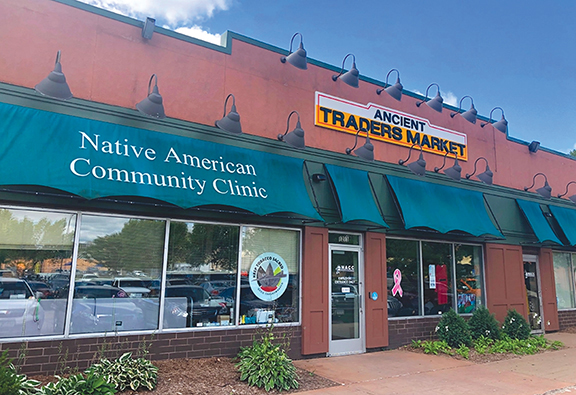
By Tiffany Bui/MinnPost
Without the same funding as tribal nations, many organizations that serve Native Americans in the cities are facing a revenue shortfall.
Five days a week, the Gatherings Cafe located inside the Minneapolis American Indian Center delivers free meals to elders. The Native American Community Clinic swabs patients for COVID-19 at a testing drive-through. And the Ain Dah Yung Center has staff standing by at parks to help displaced encampment residents.
These organizations often are a safety net for Native Americans living off-reservation in the Twin Cities, where federal treaty obligations to provide social services disappear. They also target their services to a substantial portion of the Native American population in Minnesota; about seven in 10 Native Americans reside off-reservation or in the metro area. But during the pandemic, these nonprofits are facing declining revenue as they prepare for a worsening economic crisis.
Clinic sees 30% decrease in revenue
“We’re generating less revenue because we’re seeing less people,” said Antony Stately, CEO of the Native American Community Clinic. The clinic has experienced over a 20% decrease in revenue due to a loss of insurance reimbursements.
Janeen Comenote, executive director of the National Urban Indian Family Coalition, said that nearly all of the more than 30 urban Native American organizations in the state shut their doors from March to June. Some are still closed to the public.
In early April, NUIFC surveyed 45 urban Native American nonprofits, 15 of which were based in Minnesota, and found that about $9.9 million in expected revenue had been lost across the board. The combined budget is $152.5 million.
“Our communities tend to be a bit of the canary in the coal mine,” Comenote said. “What is going to impact the rest of America usually impacts the Black and Native communities first. And these organizations are really sort of the bellwether for that.”
Treaties dictate several obligations that the U.S. government has to tribal nations in return for their land, such as providing housing and education. Some tribes, like the Navajo Nation, have also been hit hard by the virus.
But the government has no such responsibility to the urban Native population, which means the nonprofits serving them must compete for state, city and county funding just like any other group.
‘A complete misconception about the community’s experience’
Joe Hobot, president and CEO of the American Indian OIC, said that government officials often have a “complete misconception about the community’s experience.”
“They feel that ‘we’ll give money to tribes and then therefore we can check the box that we’ve provided resources to the American Indians of Minnesota.’ Well, the data shows that you’re really only engaging about one in four of the population,” Hobot said.
So when taxpayer funds are allocated specifically for tribes, “We know that the majority of that money will sail over the heads of our population in our community,” he added.
Since the stay-at-home order lifted, the organizations have rebounded slightly as they moved to a hybrid model of providing services online and in-person. Most of the surveyed groups were also able to receive PPP Loans, Comenote said.
The Ain Dah Yung Center has been losing about $16,000 a month since the start of the pandemic, said Residential Director Holly Henning. But the low-interest loans, along with COVID-19 emergency grants, have been helping the center “stomach” a lot of the hazard pay and staff salaries.

‘Pandemic, and then riots’
The Minneapolis American Indian Center received about $300,000 from the loan, and hasn’t laid off or furloughed any employees, Executive Director Mary LaGarde said. But the recovery was set back when riots following the police killing of George Floyd destroyed grocery stores and paused buses, sending the center scrambling to get families essential supplies.
“For us, it was like, pandemic, and then riots. And now, it’s pandemic and the aftermath of all of the violence. So we’ve had a double whammy here,” LaGarde said.
Though many organizations see the quick pivot to virtual services as a triumph, they worry about the clients left behind. Native Americans are often on the other side of the “digital divide” that delineates between the internet haves and have-nots, especially on reservations.
There aren’t exact numbers on the population of urban Natives without internet access, but multiple organizations cited a decrease in clients partly attributable to a lack of access to Wi-Fi.
“The concern is our ability to interface with our community … because of the pre-existing issues around the digital divide, it’s been more of a struggle for them to get online,” Hobot said. “The sooner we can have a greater impact on foot traffic and face-to-face encounters, the better.”
‘Mitakuye Oyasin: We are all related’
The pandemic shows no signs of letting up, and the nonprofits are bracing themselves as the crisis exacerbates existing disparities in housing, employment and health care. As federal lawmakers continue debating the next stimulus package, these groups are working to ensure the voices of urban Native Americans aren’t left out.
Stately, at the health clinic, sees this time of reckoning over racism and other inequalities as a prime moment to advocate for improving social services systems.
“There’s a saying in the Dakota, Lakota culture which is “Mitakuye Oyasin,” we are all related. And this virus has shown us specifically that we are all related. My ability to survive and my ability to thrive and have good health is connected to each and everybody around me. And so, we have the opportunity here also as a human race to evolve and become even better.”
MinnPost is a nonprofit, nonpartisan media organization whose mission is to
provide high-quality journalism for people who care about Minnesota.
To learn more about the Covid-19 pandemic, see the MN Dept of Health website.






